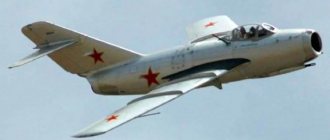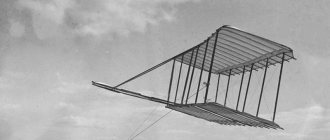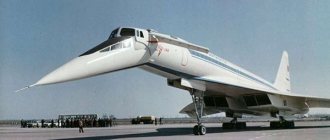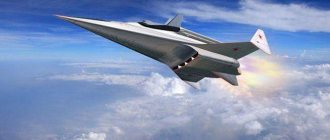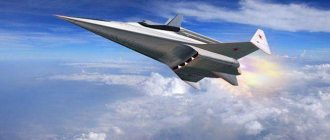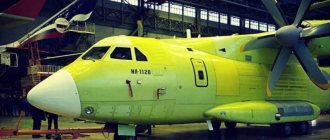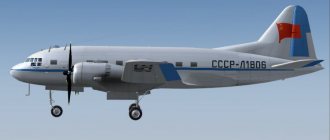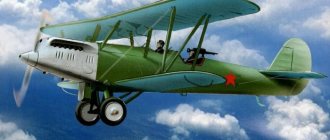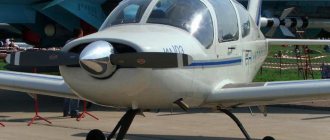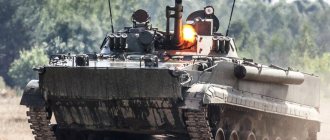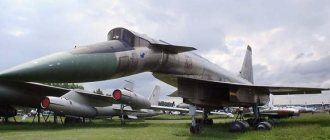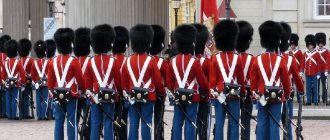History of creation
In 1946, after being invited to the Kremlin, a group of OKB-155 designers became familiar with the requirements for building a machine with a jet engine capable of reaching transonic speed. A.I. Mikoyan and M.I. Gurevich understood that the creation of such an aircraft was possible if we used all the developments of previous years on the aerodynamics of a swept wing.
In parallel with such work, the design of an ejection seat and engine for a jet aircraft was developed. We didn’t have our own engine yet; we had to go to England for experience and Rolls-Royce Nene and Derwent engines. Having bought ten English engines in 1946 and 15 in 1947, Soviet engineers studied and made drawings of the engines. Soon receiving the designation RD-45, the converted English engine was put into production.
MiG-15
In the meantime, OKB-155 finally adopted the version of a simple fuselage with two air channels from the nose of the body to the engine located at the tail of the aircraft. The factory designation for this vehicle was I-310 and three prototypes were built in 1947, one of them was equipped with an RD-45F high-reliability engine.
According to the old tradition, in the last days of 1947, OKB-155 pilot V.N. Yuganov tested a pre-production jet fighter in the air. A year passed and on December 30, 1948, the first production car was driven by the same V.N. Yuganova took off from the concrete strip of the factory airfield and performed an installation flight.
MiG-15 take off
The quality of manufactured aircraft increased every day, and the product was subject to constant improvement during production. Designer V.Ya. Klimov prepared a modernized VK-1 engine, which was used to equip the new most widespread modification, which received the index MiG-15 bis . Before going into production, the vehicle's armament was replaced - two new HP-23 and one N-37 cannons were installed. After agreement with the Ministry of Defense, the design bureau developed a project for a new training aircraft, the MiG-15UTI , and already in January 1949 the new machine was tested in flight. This “spark” has given more than one generation of pilots a ticket to the skies.
Main modifications of the aircraft
I-310 - prototype of the MiG-15. It was taken into the air on December 30, 1947 by test pilot V.N. Yuganov. There was a great loss of thrust on the plane. At the suggestion of engineer Klikhman, the nozzle and fuselage were shortened. At the same time, changes were made to the design of the controls, tail control and wing. As a result, the prototype differed from the production MiGs.
A total of three prototypes were built: S-01, S-02 and S-03.
The serial MiG-15 is the main type of aircraft, produced in a large series in variants that differed slightly in equipment and weapons, and for several years was the main fighter of the USSR Air Force and a number of countries. The first series of the aircraft did not have hydraulic boosters, engine automation, and the brake flaps had a smaller area. Since 1949, the aircraft began to enter service with combat units. On serial MiG-15s, experiments were carried out on injecting water into the compressor inlet in order to increase engine thrust, experiments on the use of launch accelerators, as well as launching from a mobile catapult. The plane's speed was limited to 0.92 M. In addition to the Soviet Union, serial production of the MiG-15 was established in Czechoslovakia, Poland and China.
Mig-15P is an interceptor with a radar installed in the forward part of the fuselage (above the air intake).
MiG-15S is an escort fighter with the ability to mount drop-drop fuel tanks with a capacity of 250 liters. Metal tanks weighing 22 kg, or fiber tanks weighing 15 kg. With the use of drop tanks, the fighter's flight range increased by more than 400 km.
The MiG-15SV is a high-altitude escort fighter, similar to the MiG-15S, but with modified weapons. The NS-23 guns were replaced by the NR-23, which had a higher rate of fire and muzzle velocity.
MiG-15UTI (in all standard documentation designated UTI MiG-15) is a two-seat trainer fighter. The cabins are divided, equipped with telephone communication (SPU), the canopy cover of the front cabin is hinged to the right, and that of the rear cabin is sliding back. Controls for lifting and extending the landing gear and flaps were installed in both cockpits, but for the trainee it is automatically turned off when the instructor controls it. Both cabins are equipped with ejection seats and canopies that are dropped in an emergency using squibs. Armament: one UBK-E machine gun (150 rounds of ammunition), sometimes there was another NR-23 cannon (80 rounds of ammunition), some examples had a radar (in the forward part of the fuselage).
The MiG-15 in its unmanned version was equipped with homing equipment. Purpose: projectile aircraft and aerial maneuverable target.
Double MiG-15UTI
MiG-15U (SU) with a limitedly mobile gun mount under the forward fuselage in the vertical plane. Armament: two HP-30 cannons (55 rounds of ammunition). Subsequently, the NR-30 guns found use on MiG-19 and MiG-21F-13 fighters, as well as on Sukhoi Design Bureau aircraft.
MiG-15LL (“Flying Laboratory”) with an increased fin height and stabilizer span, due to a slight decrease in the tail chord. Research was carried out on the aircraft on ways to combat roll backlash when making a turn.
MiG-15 (SP-1) with VK-1 engine and “Thorium-A” radar, ARK-5 compass and MRP-48. Night and all-weather interceptor. Armament: one NS-37 cannon (45 rounds) and even an NS-45. It was supposed to be used in air defense aviation. Released 1949
MiG-15 bis. It had the same dimensions and design as the MiG-15. Work on the design of the MiG-15 bis was carried out in accordance with Resolution of the Council of Ministers No. 1839-699 of May 14, 1949. The RD-45F engine (2270 kgf) was replaced by the VK-1 (2700 kgf). State tests began on September 13, 1949. In addition to installing the VK-1 engine, which entailed changes in the rear fuselage, a BU-1 hydraulic booster was installed on the aircraft to reduce the effort on the control stick, the aerodynamic compensation of the elevator was increased to 22%, and the noses of the elevator and rudder were thickened. The forward part of the fuselage also underwent minor changes caused by the installation of HP-23 cannons. The area of the brake flaps on the aircraft was also increased to 0.5 m2, and their axis of rotation was set at an angle of 22° to the vertical to reduce the pitching moment when opening. In addition, the aircraft's strength was brought into compliance with the 1947 Aircraft Strength Standards.
Tests have shown that, compared to the MiG-15 with the RD-45F, the installation of a new engine and a set of modifications led to a significant improvement in almost all characteristics, with the exception of the flight range, which decreased as a result of increased fuel consumption. The aircraft was mass-produced and became the most popular modification of the MiG-15.
MiG-15R bis - reconnaissance aircraft with additional photographic equipment. AFA-IM and AFA-BA/40 cameras were mounted in the lower part of the fuselage.
MiG-15 bis (SP-5). All-weather night fighter with Izumrud radar. Tests were completed in March 1952. The Izumrud radar was recognized as the most suitable for installation on fighter aircraft in terms of reliability and efficiency.
MiG-15 bis S (MiG-15S bis) is a high-altitude escort fighter with the ability to mount two PTBs with a capacity of 600 liters.
MiG-15 bis 45° (SI-2) is an experimental vehicle with a redesigned 45° swept wing. The aircraft was tested from the second half of 1949 and became the prototype of the MiG-17 fighter.
MiG-15 bis (ISh) - fighter-attack aircraft. Intended for striking ground targets. To solve this problem, two beams were installed under the planes, on which bombs and missile weapons could be placed. The aircraft was tested in 1958-1964.
Aircraft design
The aerodynamic design of the new aircraft was a monoplane with a swept wing in the middle position and a rear cruciform tail. The oblique beam of the wing and its spar formed a niche in the form of a triangle into which the landing gear was retracted.
The wing was equipped with mechanization of ailerons with trimmers and flap flaps extending to a certain angle during landing and takeoff modes. On the cruciform tail, the stabilizer divided the rudder into upper and lower parts.
Layout diagram of the MiG-15 bis
The fighter's power plant consisted of an RD-25F engine; later modifications, starting with the MiG-15 bis , featured the more powerful VK-1; the air flow was directed from the air intake in the bow through two channels that went around the cockpit compartment to the engine located in the tail of the aircraft .
The three-wheel landing gear, retractable in flight, had lever-type shock absorbers. The nose strut was self-orienting, the braking system was air. The landing gear was retracted and deployed hydraulically. The control system had no cables; it was rigid, based on rods and rockers. On the latest modification of the machine, hydraulic boosters were introduced into the control system.
The MiG-15's armament consisted of three cannons in the nose under the air intake - one N-37 and two HP-23. The guns were placed on a retractable carriage and, using a special winch, were reloaded within 20 minutes. Additionally, it was possible to hang two bombs of one hundred kilograms each under the wing.
The fighter cabin is sealed with forced ventilation and equipped with an ejection seat. The glass canopy provided a good overview, which is very important for air combat. The cockpit instrument panel contains flight instruments - the AGI-1 attitude indicator, speed indicator, altimeter, slip indicator and variometer, navigation instruments - a remote gyromagnetic compass, an approach system, a radio compass and a radio altimeter.
MiG-15 cockpit
The RSIU-3 radio station was intended for communication with the ground and between aircraft; the aircraft was equipped with SRO-1 state recognition equipment. On the left panel inside the cockpit there was an engine control lever, on the right panel there were switches for radio equipment and aircraft systems. In the middle there was a control handle with a brake lever and gun triggers. The pilot was comfortably located in the ejection seat.
Flight performance
- Crew -1 person
- Maximum ground speed - 1042 km/h
- Maximum speed at an altitude of 5000 m - 1021 km/h, at an altitude of 10000 m - 974 km/h
- Lift-off speed - 230 km/h
- Landing speed - 174 km/h
- Range - 1335 km, with PTB - 1920 km
- Practical ceiling - 15100 m
- Rate of climb at the ground - 41 m/s
- Climb time 10 thousand m - 6.8 minutes
- Take-off distance - 605 m
- Landing distance length - 755 m
- Wingspan - 10.08 m
- Aircraft length - 10.10 m
- Aircraft height - 3.7 m
- Empty weight: 3247 kg
- Normal take-off weight - 4917 kg
- Fuel quantity - 1210 kg
- Engine - TRD RD-45F
- Thrust - 2270 kgf
- Armament - one N-37 and two HP-23 cannons
- Suspension points - 2
MiG-15 in the sky
Features of air warfare in Korea
The Korean events deserve attention because they were the scene of a military clash of jet aircraft, which opened a new era in the history of aviation. Our MiG-15s provided air support to Chinese army units. For the American air force, the appearance of the MiG-15 was unexpected; their F-80s with a straight wing had a lower speed and turned into easy prey for our aircraft. F-86 Saber to Korea , which opposed Soviet aircraft in the air war. Our pilots did not have the right to fight and pursue the enemy over the territory of South Korea and the sea. But the Soviet pilots did not have the goal of destroying the F-86 ; the main task was not to miss the next raid of B-29 .
At that time, we did not have anti-g suits, but US pilots did, and this reduced our ability to conduct maneuverable air combat. Veterans of the Korean War recalled that the Saber had superiority at low altitudes, especially in turns, and the MiG had an excellent rate of climb and often the battle ended after the first approach. Having unsuccessfully attacked, the Saber went down, and the MiG tried to gain altitude. After which, each pilot used the best qualities of his aircraft and as a result, our MiG ended up at the top, and the American at the bottom.
MiG-15 bis
The outcome of the battle was often influenced by the presence of a radio range finder on the Saber ; with it, our planes were shot down from a long distance, about 2.5 km. This sad situation for Soviet pilots lasted until 1952, until the appropriate equipment was installed on our aircraft.
The MiG-15 proved to be excellent in intercepting B-29 ; in the spring of 1951, on the Korean-Chinese border, Soviet pilots defeated a large group of these aircraft, and in October of the same year, the Americans suffered heavy losses during raids on North Korea and did not return until the end of the war. used bombers during the day. During the Korean events, 23 air duels were won by the Soviet pilot Evgeniy Popelyaev, it was he who forced the American F-86 , which was subsequently transported to Moscow to the Central Aerodynamics Institute.
MiG-15s caused a huge sensation in the Western press - it was called the “Korean surprise” and subsequently American pilots called this theater of operations “MiG Alley”
MiG-15 MiG-15 MiG-15 MiG-15 MiG-15
MiG-15 - the best fighter of the Korean War
Zampini Diego, Seydov Igor Evgeniy Pepelyaev: the best of the best in the Korean skies For fifty long years it was considered that the “best of the best” pilots who ever had the opportunity to fly in the Korean skies was Joseph McConnell (USA, 16 victories). However, since 1994, it became known about three Soviet pilots who achieved more victories than the mentioned American. These are: Nikolay Sutyagin (22 victories), Evgeny Pepelyaev (19) and Lev Shchukin (17). One way or another, a detailed analysis of the data shows that the unsurpassed pilot of the Korean War was, after all, Evgeniy Georgievich Pepelyaev.
The hero of our story, Evgeny Pepelyaev, was born in 1918 near Irkutsk in the family of a machinist. Like many Soviet kids in the early 1930s, Zhenya was passionately in love with aviation, and when the Pepelyaev family moved to Odessa in 1937, he and his older brother Konstantin signed up for the local flying club, where they also received military training. Around this time, Evgeniy meets his future wife, the beautiful Maya Konstantinovna Fayerman.
The future ace spent most of the Great Patriotic War on a long business trip in the Far East (Nikolai Sutyagin was in a similar situation). He also suffered the loss of his older brother, who died in battle. Only once, in 1943, Evgeniy managed to get into the active army, where he took part in reconnaissance flights as part of the 162nd IAP. Once, the Yak-7, piloted by Pepelyaev, was attacked by fascist fighters. Despite the injuries received, Evgeniy managed to escape from his pursuers and return to base. He also happened to take part in the short Soviet-Japanese war of 1945, where he stormed and bombed Japanese troops, never encountering a single enemy aircraft.
At first glance, one cannot say that a glorious future awaits this simple officer. But, one way or another, his outstanding flying abilities, as well as his unique talent as a commander, did not go unnoticed, and the pilot was sent to study at the Air Force Academy. In 1947, a wedding took place with Maya and, at the same time, he was appointed to the post of deputy commander of the 196th IAP (324th IAP). Two years later, this unit was re-equipped with the latest MiG-15 jet aircraft. Soon, Lieutenant Colonel Pepelyaev masterfully mastered the control of this machine - just in time for his appointment as regiment commander, which followed in October 1950. And in January 1951, a business trip to China followed.
First victories
Before starting combat missions, Evgeniy had to deal with organizational activities associated with a large amount of staff work and the preparation of various documents.
Having finished with the bureaucracy, the pilot began to make up for lost time during the Great Patriotic War, showing extreme determination in battle. On May 20, 1951, 36 MiG-15s (196th IAP) entered into battle with 28 Sabers (335th and 336th combat fighter squadrons - /hereinafter - BEI/). Pepelyaev, who piloted the MiG-15 N0715368, finally had the opportunity to demonstrate his outstanding abilities as a pilot and gunner. It was in this battle that he opened his combat account:
Lieutenant Colonel E.G. Pepelyaev “[May 20, 1951, around 15:08-15:09 Beijing time during an air battle with a group of F-86 Sabers] fired at an F-86 aircraft from a range of 500-600 m "At the moment of shooting, I saw shell hits and their explosions on the right plane, after which the plane made a right roll from a left bank."
The shells not only hit the right plane of the Saber, but also caught the ammunition of the aircraft (F-86A N49-1080, piloted by Captain Milton Nelson, 335th BAI), which led to the explosion of the ammunition boxes of 12.7 mm M23 machine guns. Only God knows how Nelson managed to survive in his riddled Saber to Suwon, where the plane was immediately written off for scrap. The results of this “meeting” were summed up by the US Air Force, which declared its “absolute victory” in the form of three MiGs allegedly shot down by Captain D. Jabara. The true state of affairs is this: on that day, the 196th IAP lost only one MiG (piloted by Senior Lieutenant Viktor Nazarkin), which really became Jabara’s fourth victim. The victories of the Soviet regiment included two American aircraft: the first was shot down by Yevgeny Pepelyaev, and the second (F-86A No49-1313, piloted by Captain Max Weill) by Captain Nikolai Kirisov.
On July 11, 1951, Pepelyaev led a group of 26 MiG-15s to help the 176th GIAP, which took on superior enemy forces (a group of F-86 and F-80 aircraft). Having reached a position advantageous for the strike, Evgeniy, who was already piloting the MiG-15bis N1315325, opened fire from the HP-23. The distance between him and the driven Saber was about 500-600 meters. As Evgeniy Georgievich himself recalls:
Lieutenant Colonel E.G. Pepelyaev: “In this very battle, I was pursuing the Saber and there was a moment when it slowed down the maneuver, I turned under it and opened fire. Pieces of plating flew from the right plane of the Saber and it was sharply turned to the right and down. One of my pilots said: “Ready!” I did not pursue the falling plane as the battle continued. I remember well that I thought with great pleasure how later I would show the filming of a film photo-machine gun to my pilots so that they could learn how to shoot...<...>Knowing that I was covered by a wingman and another flight of Captain V.A. Nazarkin was behind me, I began the attack. But Nazarkin’s link could not provide it. Later, the flight commander explained that he lost our pair in the sun, maybe that’s it, I don’t know. The Americans, taking advantage of this, immediately took advantage of my wingman and soon shot him down. We couldn’t even bury Larionov - his plane fell into the Yellow Sea. And immediately it’s my turn. The second couple comes in from the right, and Nazarkin is silent. I realized that there would be no help, there was no time for an aerial victory, and from a height of seven or eight thousand I threw the car into a tailspin. There is cloudiness below, the upper edge is about three thousand. I’m walking, and the Saber above me is going in a spiral, but the pilot lacks skill and cannot reach me. He flew into a cloud, pulled the plane, as they say, right next to the water and onto his airfield...”
This time, the prey of the Soviet pilot was the F-86A N49-1297 (396th BEI), flown by a pilot named Reeves, who managed to return to Suwon, but the plane was severely damaged and crashed during landing. Reeves barely suffered a scratch while his plane was written off as beyond repair two days later. As always, the US Air Force announced that it was the result of an "accident".
As a result of this battle, the plane of Senior Lieutenant Ivan Larionov, Pepelyaev’s wingman, was shot down. This became a kind of “revenge” of Milton Nelson, who became Yevgeny’s very first victim just 52 days earlier: Larionov’s MiG was shot down by him. At the same time, Pepelyaev’s own MiG was attacked by the first lieutenant [analogous to the rank of “senior lieutenant” adopted in Russia] Alonso Walter, who damaged Pepelyaev’s MiG and saw that it had fallen into an allegedly uncontrollable tailspin, and calmed down from this. One way or another, Evgeniy Georgievich’s Story puts everything in its place: the first lieutenant was misled, because the Russian pilot knew how to go into a tailspin and then come out of it completely calmly. The trick worked.
Ten days later, Pepelyaev and a dozen master pilots intercepted, as it seemed to them, F-94 aircraft flying in combat formation. According to Lieutenant Colonel Pepelyaev: Lieutenant Colonel E.G. Pepelyaev. “Once I shot down an F-94 on a turn and knocked off its tail. They flew during the day, there was fog, and our airfield was closed. And they flew almost to Mukden itself. The Corps commander, Colonel Belov, chickened out. I sat in readiness <…> We took off only when, on the way back, this group had already passed our airfield. We caught up with the eight F-94s when they were already approaching the coastline. In fact, I no longer had the right to attack, since they were already over the Yellow Sea. I told Captain Bocac to attack the front four while I targeted the back line. Attacked while climbing. I gave one an F-94 from below - chips flew, and I didn’t follow him any further. I went up, I saw the other one was turning to the left. And this one, who was on a turn, knocked off the tail unit, so much so that all these pieces flew into my plane. I also pressed my head so that it wouldn’t tear off. But the debris did not hit my plane. The F-94 group scattered, and so did my pilots, each attacking his target. It was already over the Yellow Sea, so I gave the command to end the battle. Everything could have been different if I had been given permission to take off half an hour earlier <...> "In fact, the pilots mistakenly mistook the Grumman F9F Panther aircraft (311th Naval Squadron of the US Navy) for the F-94 ). Following the battle, the Soviet side announced six aircraft shot down. At least four Panthers became victims of Soviet pilots. One of the two victories claimed by Pepelyaev is absolutely reliable: F9F-2B No. 123464, piloted by Major Richard Bell (the pilot was captured). Chinese soldiers also discovered the smoking remains of another Grumman (series number 109I405116), as well as the body of the pilot - this was the “prey” of Captain Boris Abakumov. The two remaining planes were credited to Andrey Pupko. After this battle, Pepelyaev was awarded the rank of colonel...
